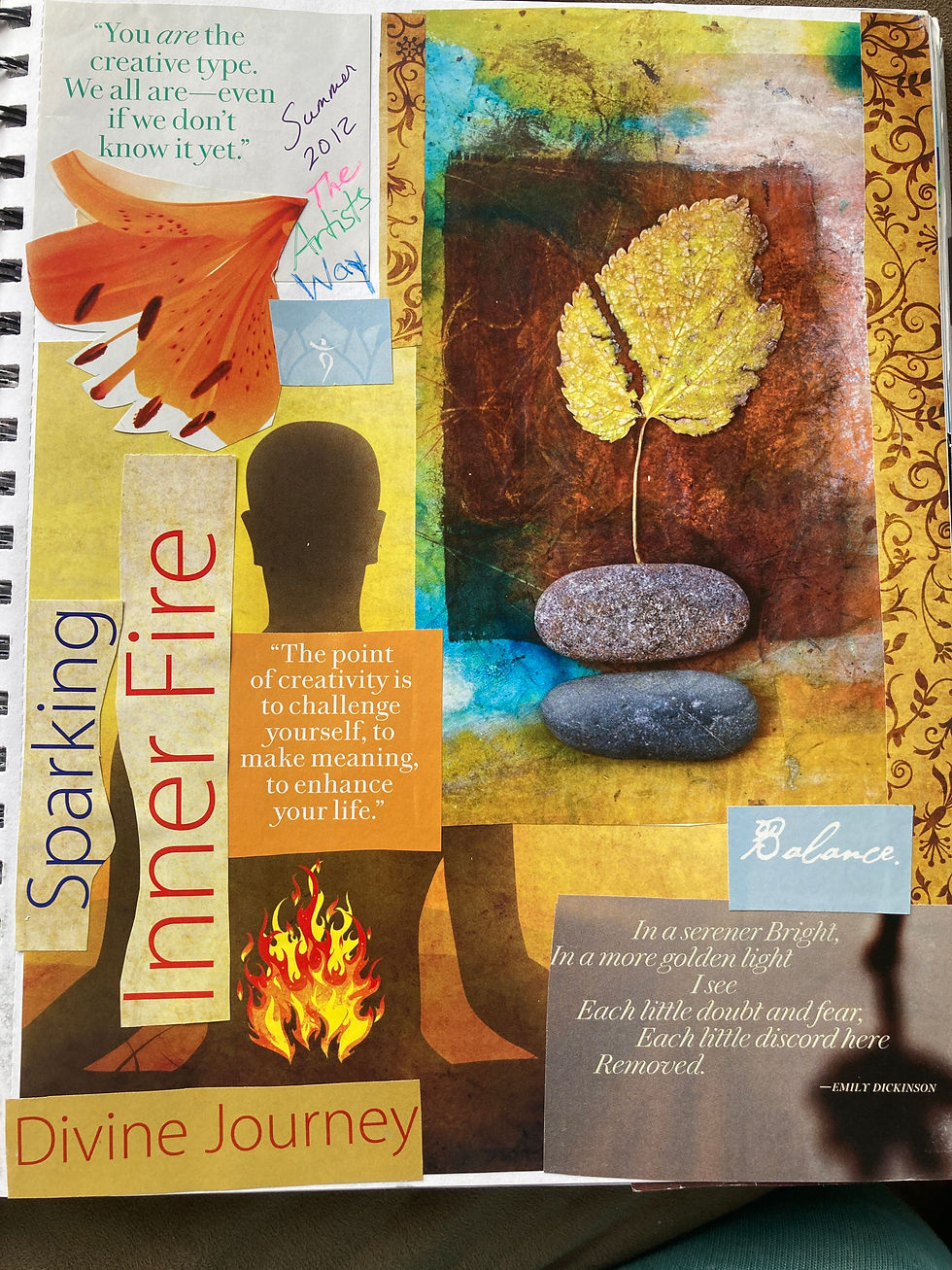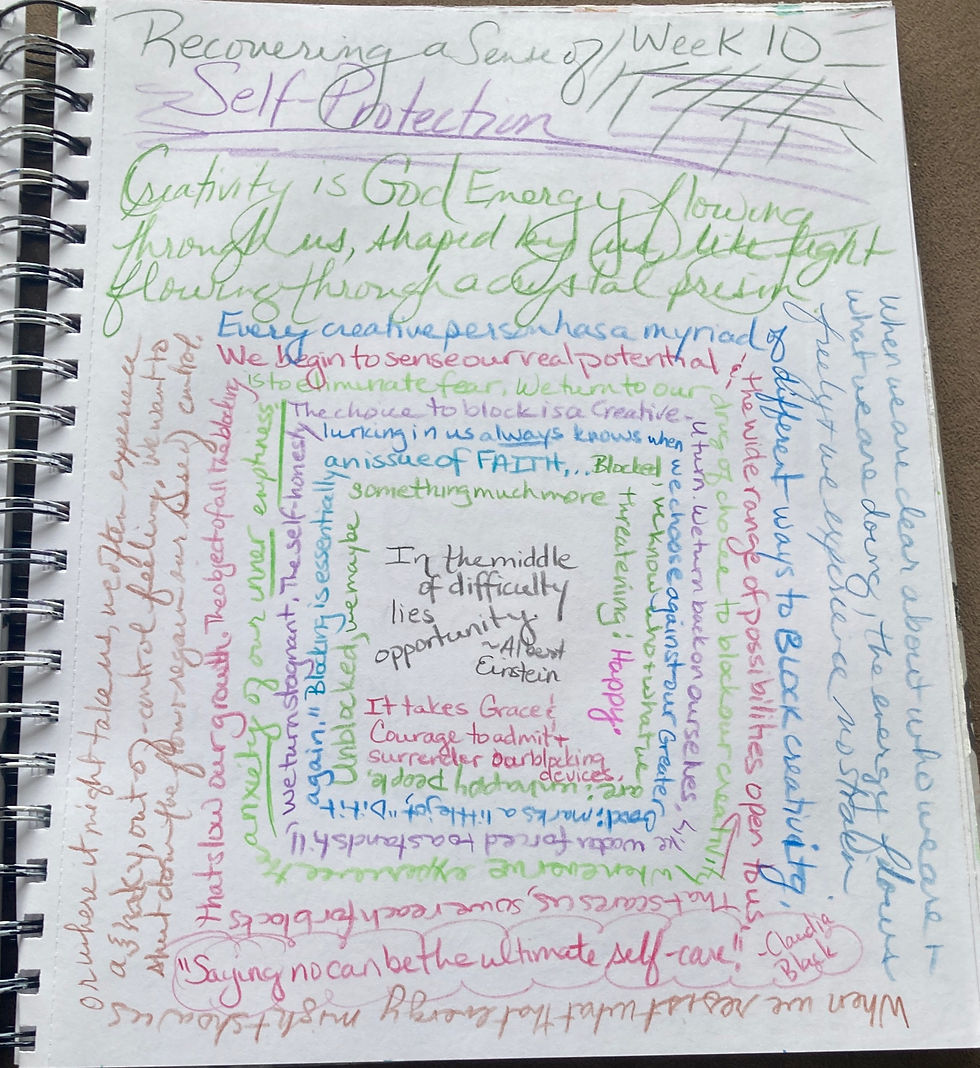Synchronicity and My Initiation into The Artist's Way
- ZHarmony

- Jul 18, 2023
- 7 min read
As my 29th birthday approached during my second year of teaching, I was beginning an inner exploration to heal old wounds. The changes and new experiences of the previous year had churned up so much that it had led to my first diagnosis of depression. During the winter of that second year of teaching, synchronicity brought me to a tribe that supported my healing as we did the work of The Artist's Way: A Spiritual Path to Higher Creativity by Julia Cameron.
On the subject of synchronicity, Cameron notes that once you begin your creative recovery, you may be startled to find it "cropping up everywhere." These words resonated deeply since it was synchronicity that had led me to The Artist's Way in the first place.
In the school where I worked, there was a small group of us in the "first year trench" sharing the uncertainties, laughter, and tears of our professional initiation. One of my trench buddies, T, mentioned The Artist's Way to me on more than one occasion, but I was too overwhelmed to follow through with it. At the end of the year, she and her husband relocated, and any thoughts I had about reading the book left with her. Halfway through my second year of teaching, another trench buddy called one Saturday for a little "spur of the moment" adventure -- there was a chilli-fest happening that day with all kinds of booths and activities. While there, I happened across a flier for an upcoming 12-week course of Julia Cameron's The Artist's Way. While my companion hadn't noticed the flier, it seemed to be calling out to me. It took a moment, but I made the connection that this was the book that T had been encouraging me to read and knew I had to join this group. Though my fellow Artist's Way group members had been strangers to me beforehand, and I haven't seen any of them since, I am forever grateful to them for the insights, support, and encouragement they provided in the sacred space we created together using TAW.

In the book's introduction, Cameron notes that because TAW is in essence "a spiritual path, initiated and practiced through creativity," the book uses the word God. Understanding that this can be challenging, she encourages readers to be open-minded and notes that to succeed in the course, "no god concept is necessary."
Cameron also introduces the reader-participant to 10 basic spiritual principles that she describes as "the bedrock on which creative recovery and discovery can be built." At the opening of each weekly gathering, members of our group would take turns reading these basic principles aloud, and discuss what phrases/concepts contained within them sparked any resonance or resistance.

Before getting into the main chapters, Cameron explains the two basic tools of the course, which I've continued to use. The first is the practice of writing morning pages -- three handwritten pages in a stream of consciousness each morning. If nothing comes to mind, just keep writing some word or phrase over and over until the words begin to flow again. I usually use the phrase "I don't know what to write." Morning pages are, as Cameron states, "not meant to be art, smart, or even writing at all." Cameron reassures that morning pages are most often negative, self-pitying, and repetitive. That certainly was so for me. During the 12-week course, and for several years beyond that, my negative self-talk was all too evident, my journals will filled with them. No matter where I was living or what I was doing and experiencing, my deep wounds continued to ooze all over those pages and seep into my lived experience. It is no wonder then that several years later I fell into an even deeper hole of depression and anxiety -- the spiritual crisis that finally burned away so much of this junk from my being. Though I still experience smaller bouts of depression from time to time, those kinds of thoughts are completely foreign to me now; I just don't think of myself in such a negative and shameful way anymore. My morning pages are mainly a general reporting of what's going on and what I think and feel about it, rattling on about mundane to-dos and petty grievances. In their midst, unexpected nuggets are mined as well. As Cameron states, "It is impossible to write morning pages for any extended period of time without coming into contact with an unexpected inner power...the pages are a pathway to a strong and clear sense of self...Anyone who faithfully writes morning pages will be led to a connection with a source of wisdom within."

The other basic tool is called the artist date, a play date you have with your inner artist. This block of time, about 1-2 hours weekly, is a commitment to "nurturing your creative consciousness." While the morning pages bring focus inward, the artist date brings focus outward for some sensory play - interacting with color, texture, sound, and images. This play date can be anything: buying yourself some paints, yarn, fabrics etc. and playing/creating with them; playing your favorite music while dancing around the house or cooking a new recipe (or old favorite meal); taking yourself out for a meal or movie; visiting a music, antique, or fabric store or going to the botanical gardens, a museum, or concert. My absolute favorite artist date that year was getting all dressed up and taking myself out to "An Evening with Bach Cantatas." I still remember the dress I wore that night and how enchanted I was by one of the choral members who exuded such delight with not just their face, but entire body! Such joie de vivre!!
The artist date need not cost money nor leaving home. During times of resistance or stagnation, my artist date is likely just coloring and/or doodling or taking a walk in the park and snapping some photos with my cell phone. Sometimes it's taking a trip to the art store and just allowing myself to look, touch, and be inspired without making a purchase. Sometimes it's using my colored pencils and sketch books for taking notes on what I'm reading. Now that I live on the beach, my artist dates include collecting and/or painting seashells.

Each week of the course then digs in to "Recovering a Sense of" something, beginning with safety, identity, and power. (As someone prone to power struggles nearly all her life, that's the chapter to which I most regularly refer.) Sprinkled throughout the chapters are quick exercises that are easy to do while allowing a little further exploration and insight. Some of them are even labeled "Detective Work" and one of my favorites is from Week 3, where you free associate a sentence or 2 with prompts like: "My favorite childhood toy was..." and "If I could lighten up a little, I'd let myself..."
The chapters of The Artists Way aren't very long, about a dozen or so pages with many thought-provoking and inspirational quotes in the margins. At the end of each chapter is a list of tasks (usually about 10) to help you dig a bit deeper that are often interesting, or yield interesting results. Cameron encourages doing at least half of them, paying attention to which ones interest you and which ones create some kind of resistance, and then dig into a combination of both.

After the list of tasks for the week, there's a Check-In section that asks how many days of the week you accomplished morning pages, what your artist date was and how it felt, if you experienced any synchronicities or if anything else of significance came up that week. Our group would begin our gatherings reading aloud the basic principles and then move to this check-in, which would get the ball rolling on all kinds of thoughts and reflections about the material of the previous week, how we interacted with it, and what we gained from/struggled with it in the process. Towards the end of our gathering, we'd read the introduction of the upcoming week and skim through it, including the tasks, getting a sense of what the new week would bring. Our goal was to read the chapter in the first part of the week, so that we had time to work on a good amount of the tasks before meeting again.

We wrapped up our course together a few weeks before my school year also wrapped up, and it's difficult to describe now how the experience opened me to new thoughts and experiences back then over those 12 weeks, allowing a new sense of confidence and joy within. I continued to not only be aware of synchronicities, but appreciate them as they appeared. Two years later, I was living in a different state and began the course again, but on my own that time, checking in with a friend designated as my "accountability buddy." A year after that, my old friend/new roommate and I took the course together (her first time) at the local community college. The following year, she and I led the course with a small group of friends in our home. There were always new insights to gain, experiences to have, and more to learn. The year after that was when I experienced my spiritual emergency. Though it may have been the worst depression I've ever experienced, it left me living a more authentic life with less shame and more peace. In the years since, I've gone through the course at least another four times, either solo or with just one or two friends at a time. As a result, my copy of The Artist's Way is well-worn and all marked up -- a treasured resource to which I continually refer. I'm so thankful to Julia Cameron for putting it out into the world.
Before encountering The Artist's Way, while dreaming of being a writer, I'd never dare call myself one. I felt like an undeserving imposter playing at being both a professional teacher and adult. Since then, and in no small part because of The Artist's Way, I've dropped the imposter syndrome and claimed being a writer before anything I wrote ever got published. I delight in creating art for the pure pleasure of it and not only allow, but embrace Beginner's Mind, playing around with new things, even as my approach is awkward and clumsy and yields "bad art." I pay great attention to synchronicities and value their importance in my creative process. I thank Tania for planting The Artist's Way seed in my life and Heather for her spontaneous invitation to bring me along to a chili-fest that delivered me to The Artist's Way right on time!

Cameron, J. (1992). Artist's Way: A Spiritual Path to Higher Creativity. Tarcher.





Comments